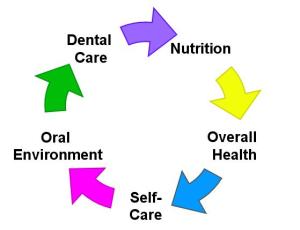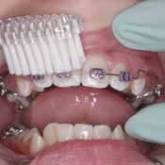2/7/2014 5:29:52 PM
Oral health is an intricate relationship between self and professional care, oral environment, nutrition, and the health of your entire body. If any one of these are out of wack, you may not be able to make up for it in another area. Understanding this balance can result in much better results.

Why do each of these matter?
Oral Self Care– Self care is often more stressed than other factors because it’s easy for your hygienist to identify and can be immediately addressed. Brushing, flossing, rinsing with antibacterial mouth rinse, fluoride use, etc. However, sometimes unnecessary frustration can occur when problems still exist after good homecare. Technique may need to be addressed or a totally different piece to the puzzle needs attention.
Professional Care— Have a dental cleaning and check up at least twice a year for early prevention! Bacterial plaque and calculus/tarter can become very organized and harmful in a short amount of time even in the cleanest of mouths and should be professionally removed at least twice a year. This process is exaggerated in people with gum disease, dry mouth and other oral diseases. Your dentist may suggest you come in 3-4x a year.
Oral Environment— Research has shown some people are more susceptible to oral disease because of their oral environment. Saliva flow, pH, bacterial flora (the kind of bacteria that tend to hang out in your mouth), and mineral content in saliva are huge players in oral health. Sudden changes in these elements can result in devastatingly fast decay, calculus build up, or gum disease.
Nutrition— Good nutrition for your mouth is much bigger than limiting sugar and soda consumption. Did you know the length of time is actually a much bigger factor than amount consumed?
Here are a few things, out of many, that can cause cavities: Starchy carbs (potatoes, crackers, pretzels), sweet drinks (juice, soda, sweet tea, lemonade), dry foods (rice cakes, oreos), sticky foods (fruit snacks, raisins, syrups, dried fruits), sugars and syrups. Consuming these things will increase your risk of cavities in general but especially if you eat them slowly over time.
Eating a healthy balanced diet will also increase your body’s ability to fight disease and inflammation.
Overall Health Have you ever heard the expression ‘You don’t look a gift horse in the mouth?’ We’ve known for many years that oral health is closely tied to the health of your entire body! Unfortunately, many diseases decrease your ability to heal and fight off disease. This can cause damage in your mouth. The inverse is also true: Good oral health can increase the health of your entire body. Poor oral health has been linked to diabetes, alzheimers, heart disease, and stroke.
4/11/2013 7:46:58 PM
Early detection of oral cancer is key in beating the disease! Regularly screening yourself at home and attending dental appointments at least twice a year can be a matter of life and death.
So pull out your mirrors and flashlights folks, and get ready to say AH!
What to look for:
- Any ulcers, red, bumps, or white spots that do not go away within 2 weeks. One of the most common signs of cancer is an ulcer that does not heal. These often go unnoticed because they can be painless.
- Stick your tongue out as far as it can go, pull it to each side, and push it to the roof of your mouth. The most common places for oral cancer are the sides of the tongue and floor of the mouth.
- Say “Ah!” A sore throat is associated with a laundry list of issues including allergies, the common cold, strep throat, but is also a sign of HPV or Human Papilloma Virus.
- Pull out your lips and look in every nook and cranny!
4/1/2013 3:17:05 PM
Last month’s trivia question was a bit easier than the previous few have been. The hardest substance in the human body is enamel. Enamel is 7 times harder than the substructure of the tooth called dentin.
Congratulations to Christina for winning the drawing and a $40 gift card to PF Chang.
This month we will be playing for a $40 gift card to Zio’s. Good Luck!
What is the most prevalent disease in the United States among those ages 6-20 years old?
A. the common cold
B. tooth decay
C. tuberculosis
D. Hepatitis A
E. Diabetes
You can respond by emailing, calling or by Facebook.
719-593-9025 or springsdentistry@gmail.com
3/5/2013 7:11:28 PM
Last month’s question was about a nocturnal horse riding silversmith who was also a dentist who did the first forensic dental identification known in America. The answer was Paul Revere.
He made a silver and ivory dental bridge for Dr Joseph Warren, a general in Washington’s Army during the American War of Independence. The general was killed at the Battle of Bunker Hill and buried in an unmarked grave with several other soldiers. A year after the battle, the bodies were recovered and Paul Revere identified Dr Warren’s body on the basis of the bridgework he had done.
Congratulations to Marvin for getting the answer right and winning the drawing for a $40 gift card to Carrabbas.
This month we are playing for a $40 gift card to PF Chang. Good Luck!
Question:
Teeth are harder than bone and are the last part of the body to be broken down or destroyed. Which component of the teeth is the hardest substance in the human body?
- A. Dentin
- B. Pulp
- C. Enamel
- D. Sharpey’s fibers
You can respond via Facebook, email, calling in or by filling out the paper at the front desk.
2/5/2013 5:19:49 PM
Last month’s trivia question dealt with the first known successful implant dentistry that was discovered in 1931. The Mayans were the civilization that first implanted shells into the jaw bone to replace missing teeth around A.D. 600.
Congrats to Tami for getting the answer right and winning the drawing of a $40 Olive Garden gift card.
This month we will be playing for a $40 gift card to Carrabba’s. Good Luck!
Question: Although I am more well-known as a silversmith who indulged in nocturnal horse-riding, I was also a practicing dentist. I performed the first documented case of forensic dental identification in America. Who am I?
A: Ben Franklin
B: George Washington
C: Paul Revere
D: Florence Nightingale
E: Amerigo Vespucci
You can respond via Facebook, email, calling in or by filling out the paper at the front desk. At the end of the month we will be doing a drawing for all of the correct answers to win the gift card. We will notify you via facebook, the blog or by calling you.
12/17/2012 2:13:45 PM
A man with a sparking smile can certainly lure the ladies, but a gentlemen wishing to maintain his sex life should hold on to his toothbrush, according to a new study, published in the Journal of Sexual Medicine, that finds a correlation between gum disease and erectile dysfunction. Researchers at the University of Malatya in Turkey looked at 160 men, ages 30 to 40 years old, half of whom had erectile dysfunction. Among the impotent men, 53 percent also were found to have inflamed gums, compared with 23 percent in the control group. The average age of men in this study was under 36.
Happy flossing!
9/17/2012 1:50:59 PM
Prescription toothpaste often contains a higher amount of fluoride or other controlled ingredients than is available over the counter. These more concentrated substances are able to accomplish more. Prescription fluoride toothpastes have up to 5x the fluoride content of their non-prescription counterparts.
Why are they sometimes necessary?
1. Decay — Fluoride is a proven strong line of defense for someone who struggles with basic frequent cavities.
2. Receding gumline — The root surface of a tooth is far less protected than the crown and as the gums recede these areas are very prone to sensitivity and decay.
3. Orthodontics/Braces — Plaque control can be quite difficult around braces and puts the orthodontic patient at high risk for cavities
4. Dry Mouth — Saliva is a natural defense against cavities as it buffers acid and sweeps food and debris out of our mouth. Low saliva production is a quick way to problems.
5. Restorations (crowns, fillings, bridges) — These areas can be more difficult to clean. Just like orthodontics and dry mouth, the accumulation of extra plaque and debris increases risk of cavities.
8/22/2012 3:20:33 PM
A predominate problem with orthodontic treatment (braces) is the increased risk of cavities. Decay first shows in the form of a white spot that can then turn into a hole or a dark spot. These are most often found around the brackets and in between the teeth. These white spots don’t go away and can be a real esthetic problem after the braces are off!
How do you prevent decay while in braces?
1. Brushing well around braces and wires. Plaque builds up more easily and is harder to remove around brackets. Point your toothbrush towards your gums first to get one side of the bracket and then flip it to reach the other side of the bracket as such:

2. Flossing, waterpik, proxybrushes etc. Get between those teeth! Brushing only reaches 60% of your tooth surfaces.
3. Fluoride. Using toothpaste with high fluoride content and having in office fluoride varnish treatments strengthens your teeth and makes them more resistant to decay. Fluoride can make the difference between white spots and full blown decay.
4. Avoiding sugar and non complex carbohydrates. Sweets, white breads, crackers and white pastas are easily broken down by the bacteria in your mouth to create decay quickly. Braces tend to catch food so these decay causing foods will stick around longer and do more damage.
5. Avoiding acid. It’s not just about the sugar. Many sugar free drinks are just as acidic as drinks containing sugar! If ascorbic acid (or any acid) is high in the list of ingredients it is more likely to cause your problems. Common drinks high in acid include diet soda, crystal light, sports drinks (with or without sugar), vitamin water, and energy drinks. It’s important to even be careful with lemons, limes, oranges, and any drinks made from them due to their high acid content.
6/25/2012 8:41:27 PM

As our Colorado summer comes into full swing, we see friends on the volleyball and basketball courts, kids skateboarding and rollerblading, and people out on their bikes. With all these fun outdoor activities comes the risk of injury. It only takes one bad move to permanently damage your teeth or lose them, so why risk it? Just as you’d wear your seatbelt to drive your car, wear a mouth guard while playing sports to prevent the unthinkable!
While a professionally fit mouth guard provides the best protection for your teeth, boil and bite mouth guards purchased in store also minimize the risk of tooth loss considerably. This is a great option for someone who isn’t involved in these activities on a regular basis. These function much better than ready-to-wear stock mouth guards because they are formed more securely to your teeth.
4/17/2012 7:19:06 PM
As an adult, do I still have to worry about cavities?
This common misconception is likely from when fluoride treatments were only for children. Adults and children of any age can develop decay. Furthermore, recent research has shown that fluoride varnish treatments help prevent and arrest decay in adults that are high risk too. Adults with old restorations, gum recession, or dry mouth are more likely to experience decay. As gums recede, the softer dentin of the root surface is significantly more susceptible to acid and decay. Saliva is also important for sweeping harmful acid and food from the mouth, so reduced salivary flow greatly increases risk for cavities.